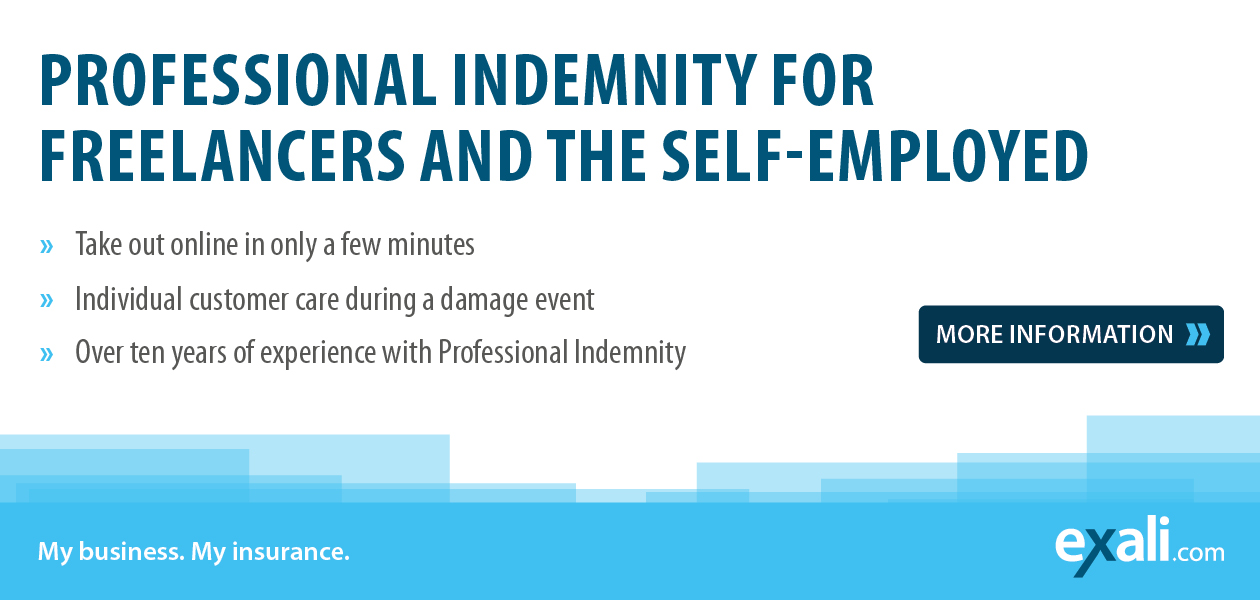Hourly Rate Calculation For Freelancers
What does my service cost? This is one of the most important questions for freelancers, especially at the beginning of their work - after all, the business should bring in enough money to be able to make a comfortable living. We spoke to Stefania Volpe from freelancer project platform freelancermap.com about how to do this and how to avoid discussions with your clients about hourly rates.
Hourly Rate - A Question of Sector?
exali: We often read that freelancers sell their services for less than they are worth - is this really the case or is it more of a sectoral phenomenon?
Stefania Volpe:
In some cases, it could be an industry-specific phenomenon, where certain fields or sectors are more competitive, leading to downward pressure on prices. In highly saturated markets, freelancers may feel compelled to lower their rates to remain competitive and secure projects.
On the other hand, individual factors also play an important role. Some freelancers, especially those starting out or trying to build a client base, may initially offer lower rates to attract clients and gain experience. As they gain expertise and build a reputation, they may gradually increase their prices. Geographical location can also influence pricing, as the cost of living, economic conditions and culture vary from region to region.
Our advice is to avoid underpricing your services if possible. While offering cheap services may attract some clients, it could also be perceived as a sign of low quality. It's essential to strike a balance between competitive pricing and the value you bring to the table.
Hourly Rate Setting Factors
exali: What factors should I consider as a freelancer when calculating my hourly rate?
Stefania Volpe:
Calculating your hourly rate as a freelancer requires careful consideration of several factors to ensure that you are pricing your services fairly and sustainably.
Some key factors to take in to account are:
- Skill and experience: According to our freelancer study 2023, high qualifications and years of experience equal higher hourly rates. Assess your level of expertise and experience in your field and adapt your rate consequently.

62 per cent of freelancers increase their rates the more experience they gain.
- Industry rates: It is advisable to research the standard rates for freelancers in your industry and location. This will give you an idea of the market rate and help you stay competitive.
- Cost of living: When calculating your hourly rate, you should consider all your monthly living costs and expenses, both private (e.g. food, clothes, rent, car, …) and business ones (e.g. office, taxes, working material, certifications, …). Your hourly rate should cover these costs and leave room for profit. Tip: Start to make a list of all the expenses you may incur into.
- Workload: Consider how many billable hours you expect to work in a week or month, but also non-billable hours for tasks like marketing, administrative work, and professional development. Also, do not forget to include some days off for vacation, sickness, training.
- Legal and financial considerations: Keep in mind that your hourly rate should also cover taxes, insurance, and other financial responsibilities.
- Value proposition: Evaluate the unique value you bring to your clients and how your skills solve their problems or fulfil their needs. A strong value proposition can justify higher rates.
- Supply and demand: Consider the demand for your services and the level of competition in your niche. Higher demand and limited supply can support higher rates.
- Client budget: Understand your target clients' budget and ability to pay for your services. Adjust your rates accordingly for different types of clients and projects, taking into account the most appropriate pricing strategy.
- Project complexity: Some projects may require more specialised skills or involve greater complexity, which may justify higher rates.
- Market positioning: Decide on your market positioning - whether you want to position yourself as a budget-friendly option, a premium service provider, or somewhere in between.
Remember that setting your hourly rate is not a one-off decision. Re-evaluate your rates regularly based on your experience, skills, and market changes. Being transparent with clients about your rates and the value you provide will help build trust and foster successful working relationships.
Never Undervalue your Services
exali: What are the most common mistakes you see freelancers make when calculating their hourly rate?
Stefania Volpe:
Potentially, all of these factors can lead to an error if not carefully considered during the calculation: not considering all monthly costs, neglecting the profit margin, overlooking the time spent on non-billable tasks such as administration, client communication, and marketing, underestimating your experience, or not evaluating the value you deliver to the client.
However, the most common mistake 64 per cent of freelancers make is charging too little at the start of their career (source: freelancermap Freelancer Study 2023). Competing solely on price can lead to a race to the bottom Freelancers may offer very low rates to win projects, but this can make it difficult to raise their rates later and maintain a sustainable income. To avoid these mistakes, freelancers should conduct thorough research, assess their costs, value their skills, and regularly review and adjust their rates based on market trends and their own growth. Communication your value proposition effectively can also help justify higher rates and attract the right clients.
exali: Does it make sense to charge the same hourly rate for every job, or is it also worthwhile in some cases, for example, to offer a "regular customer discount"?
Stefania Volpe:
In the early stages of your freelance career, it may be feasible to charge the same hourly rate for each job with different clients. However, as you gain more experience and expertise, it is advisable to review and adjust your rates or consider alternative pricing models, such as project-based or value-based pricing, to ensure scalable income.
Offering regular discounts may imply that you undervalue your work. While this may be worthwhile in certain situations, it is important to be aware of the potential downsides. Offering discounts could send the message that you are willing to compromise on your pricing or give the impression that your initial prices are too high.
Ultimately, the decision on pricing strategies depends on your business strategy, market demand, and the nature of your freelance work. It is important to carefully weigh the pros and cons of each approach and determine what best suits your goals and the preferences of your clients.
Focus on your Offer
exali: As a freelancer, how can I avoid discussions about hourly rates?
Stefania Volpe:
The key is to move the focus away from hourly rates and encourage more productive discussions centered around the value you bring as a freelancer. For example, you can:
- Offer fixed packages rather than hourly rates
- Base your pricing on the value and impact you deliver to clients
- Display your pricing upfront on your website or in proposals
- Showcase your portfolio and client testimonials to demonstrate your expertise
- Highlight your efficiency and ability to deliver quality work in less time
- Create contracts that clearly outline the scope of work and payment terms
Hourly Rate Calculation - an Example
exali: Let's get specific: What would an example hourly rate calculation look like? Stefania Volpe:
You can calculate your hourly rate by following these steps:
1.) Calculate all your monthly expenses (living costs + business costs) and multiply it by 12
months: €4,000 x 12 months = €48,000.
2.) Determine your profit margin, which is your desired annual income: €60,000.
Total costs for running your business: €48,000 + €60,000 = €108,000.
3.) Calculate the number of days you will work by subtracting weekends, days of vacation, bank
holidays, sickness, and trainings from the total days in a year. For example:
Weekends: 104 days
Vacation: 30 days
Public holidays: 10 days
Sickness: 5 days
Total working days: 365 - 149 = 216
4.) Estimate the number of billable hours per day (excluding non-productive time like
administrative tasks, client acquisition, accounting, etc.). For instance, if the freelancer
works 6.5 hours a day, the total billable hours would be 1,404 hours in a year (216 workdays
x 6.5 hours/day).
5.) Now it's time to calculate the minimum acceptable rate (MAR) you want to work for:
MAR = ((monthly costs + salary) / (hours worked in a year)) + tax
According to our example: €108,000 / 1,404 = €77 per hour + tax.
Please note that this is a starting point, and freelancers may adjust their hourly rates based on market demand, their level of expertise, and the complexity of the projects they work on. It's essential to continuously review and adjust the hourly rate as needed to ensure it aligns with the freelancer's goals and market conditions.
Thank you very much for this informative interview!

She loves marketing, the digital world, foreign languages and meeting different cultures. She moved from Italy to Germany thanks to an exchange program at the university and worked as marketing manager for several startups. Now she focuses on helping freelancers and IT professionals to find jobs and clients worldwide at www.freelancermap.com.
About freelancermap:
freelancermap is one of the leading project platforms for freelancers and companies in the IT and engineering sector. The aim is to bring together highly qualified IT specialists and companies with personnel requirements - quickly, directly and without placement fees. Freelancermap offers freelancers and companies an independent platform for the realisation of their IT projects. You can also find out more about freelancermap at their Website

Vivien Gebhardt is an online editor at exali. She creates content on topics that are of interest to self-employed people, freelancers and entrepreneurs. Her specialties are risks in e-commerce, legal topics and claims that have happened to exali insured freelancers.
She has been a freelance copywriter herself since 2021 and therefore knows from experience what the target group is concerned about.









